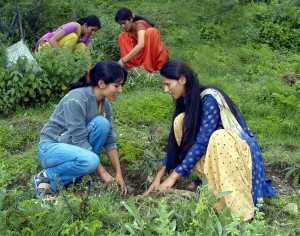
Speaking about the study constituted, Vinay Tandon, principal chief conservator forest said that though trees flowering out of sync with the season that they are due, movement of bees, changing in breeding seasons of birds were all being noticed and reported but to document a shift in the climate zone taking place, the study about shifting tree line has been instituted.
In the north western Himalayas, the transitional tree line starts at 10,000 feel altitude, said the forester, and by 12,000 feets changes to shrub and alpine pasture vegetation.
Horizontal shifting of trees and accompanying flora indicates changes in precipitation patterns where as tree line moving higher in the transition directly relates to warming in the zone, he said.
As trees that used to grow at a particular altitude are now becoming at higher altitudes, this study would help to document the changes taking place.
More than mitigation measures to check climate change, findings from the study would help in adopting adaption strategies in facing the changes coming about, said Tandon.
Another change being noticed was perennial streams fed by glaciers turning into rain fed seasonal ones, he said.
Senior scientists RK Sood, who is a joint secretary with state council for science, technology and environment, reacting to changing weather patterns said that though season shifts were noticeable but one needed a longer term study to ascertain whether it was only a cyclical change or a progressive pattern in global warming.
As Editor, Ravinder Makhaik leads a team of media professionals at Hill Post.
Spanning a career of over two decades in mass communication, as a Documentary Filmmaker, TV journalist, Print Media journalist and with Online & Social Media, he brings with him a vast experience. He lives in Shimla.



We need to ask ourselves as how many tress we ourselves planted since we are born. Just organising van mahotsav and planting few saplings in a year wont help an inch in wide gap of environmental degradation.
What will be the fate of our planet after few years when in even our country where 125 crores of people eat, drink and consume natural wealth like termites. Ye environment protection and seminars are all bogus issues, no one bothere after the seminar is concluded, the speakers just “draft good speeches and walk around with appreciation” and earth keeps cring everyday for happening disasters.
Why not media creates a campaign where planting a tree by every citizen becomes a legal binding duty. no use of intellectualism and words of great concern, at the end of every discussion we people just look for “how to feed our homes and manage more resources to live comfortably.
My dear Rajneesh, it is the misfortune of our country that persons like you, who feel the pain of mother nature, can be counted on fingers. Even the bureaucrats responsible for implementation of our policies are least bothered, but I do have some hopes from our present Minister of Environment & Forests, Jairam Ramesh. He is more serious and dedicated than his earlier counterparts who did not even visited the fields even once during their tenure.
The country where Vanaspati had a prominent role in all the aspects of life is facing this problem.The level of dedication required for planting and sowing the seeds of wild fruits and nuts is lacking/going down.The country which was a role model for others is now following others.The productivity of the area is directly proportional to the vegetation cover which is lacking now
The upward shift in alpine treeline is a global phenomenon, however, the pace of shift in Himalaya may be different (higher side) than the global average. The satellite remote sensing based study carried out by Space Applications Centre (ISRO), Ahmedabad suggests that there is an average 300m shift in past 3-4 decades as far as Uttarakhand Himalayan is concerned. The simulation studies also suggests that leading alpine treeline species would be loosing ground in coming future (with reference to IPCC-4 scenario).
The study taken up to note the phenological changes on the ground is a good effort to understand the climate vs changes in pattern of events of vegetation. To have a proper plan of monitoring the alpine region of Indian Himalaya we need to take up studies on the line of GLORIA. There is no GLORIA site in Indian as of now. It would be highly appreciated if GLORIA sites is established in India. Key requirement for a setup of GLORIA sites is a good mountain team (4 persons at least), where 2 should be experienced botanists who can identify most of vascular plant species in the field. Sites are to be established on mountain summits above the climatic timberline – fieldwork for setup plus recording may take around 3-4 weeks. Costs fro temperature loggers are around EURO 3000. The GLORIA field manual available at GLORIA website (www.gloria.ac.at) may be taken as guideline.
Starting a GLORIA site does not require any bureaucracy. Just, inform them once a concrete plan with the particular selected site is done. And after fieldwork, the data needs to be uploaded to the central GLORIA database.
In Nepal part of Himalaya, the ICIMOD has a GLORIA site. I think, we need to move on and have collaborations with international bodies to monitor this global phenomenon.